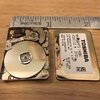Hello, I am trying to build a micro gimbal that can stabilize ultralight cameras, yet retain higher precision that standard servo gimbals of these gimbal’s design. The pico analog 5V camera that some company’s offer weigh about 1.4 grams, and if I double the weight as a capable of two cameras with one as backup, the gimbal would have to carry at most 3 grams.
I would want to use the hhd out of the Nokia 91, and use a rotary encoder so I can turn it into a rudimentary brushless motor. I was wondering if anyone knew if any rotary encoders that are size of the components in the spinning axle part of the nokia 91 hhd, pictured here:
https://www.aliexpress.com/item/1005004080808553.html
Secondly, beside building a diy rotary encoder of this scale, or purchasing one, I have one more issue to solve. Does anyone have any links for sliprings of the scale of hhd?
I am trying to find the smallest sliprings available, they only need to have power ground, and one third (wire analog for video). Building one could be an option, however I was wondering what the available, that have miniature form factor, and are very light weight. Any product selection recommendations or advice would be appreciated, thanks.
I have considered using brushless motors, but the lightest motor I could find is 1.4 grams, and I would like to ask if this project is feasible, to get precision control out of the Nokia 91 hhd drive, for controlling a nano sized gimbal.
I would want to use the hhd out of the Nokia 91, and use a rotary encoder so I can turn it into a rudimentary brushless motor. I was wondering if anyone knew if any rotary encoders that are size of the components in the spinning axle part of the nokia 91 hhd, pictured here:
https://www.aliexpress.com/item/1005004080808553.html
Secondly, beside building a diy rotary encoder of this scale, or purchasing one, I have one more issue to solve. Does anyone have any links for sliprings of the scale of hhd?
I am trying to find the smallest sliprings available, they only need to have power ground, and one third (wire analog for video). Building one could be an option, however I was wondering what the available, that have miniature form factor, and are very light weight. Any product selection recommendations or advice would be appreciated, thanks.
I have considered using brushless motors, but the lightest motor I could find is 1.4 grams, and I would like to ask if this project is feasible, to get precision control out of the Nokia 91 hhd drive, for controlling a nano sized gimbal.


